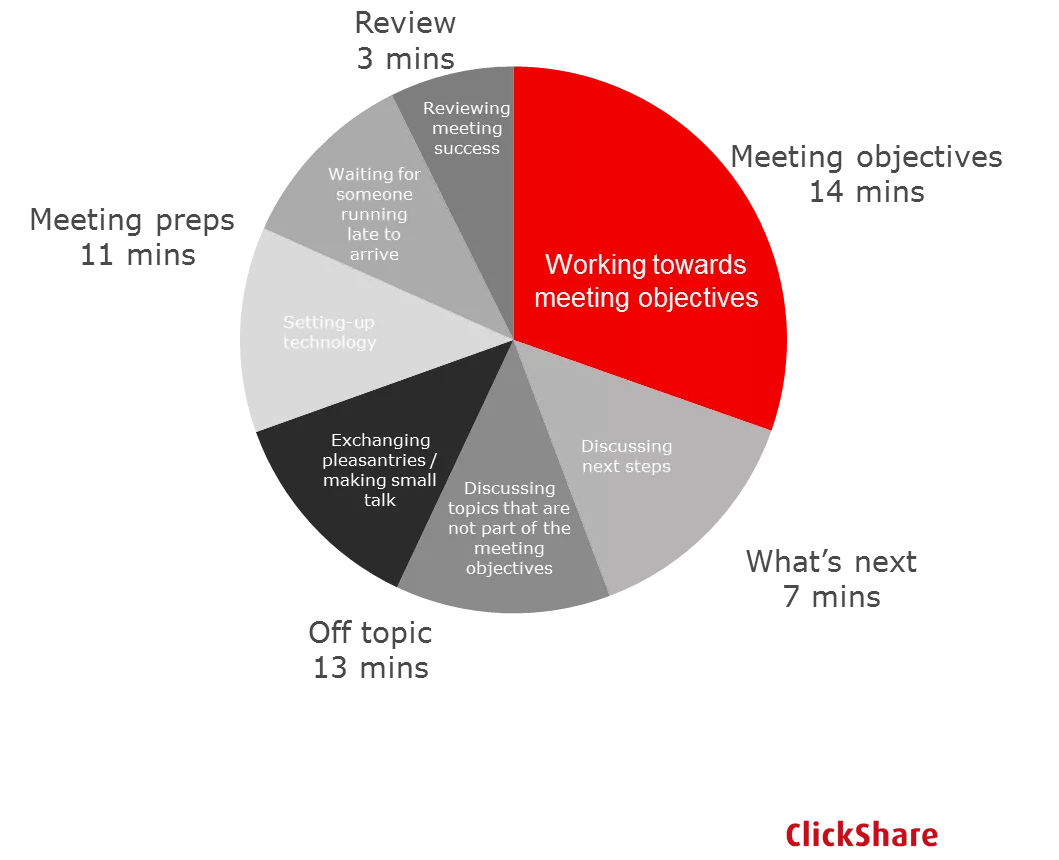Rethinking collaboration: Barco reveals true extent of time lost in meetings, and shows how businesses can reclaim this time to their advantage
- Survey takes in the views of 3,000 white-collar workers worldwide, across multiple industries and roles
- Results show employees spend an average of one day a week in meetings, or 50 days a year
- 51% of employees are invited to meetings that are irrelevant to them, a misuse of time and resources
- 37% of workers admit to using whatever technology is necessary to get the job done, even if it’s not secure.
- Objectives matter: 61% of C-suite executives are often unclear what they’re in a meeting to achieve
Joining forces with Circle Research, Barco surveyed nearly 3,000 white-collar workers in Europe, the Pacific, the US, China and India. The research sample was aged between 21 and 65 and was employed across a range of organization sizes, industries, job seniority and roles.
One of the report’s most significant findings was the number of meetings people have – on average 10 per week – and the length of those meetings. Most booking tools only allow standard one-hour time slots, yet the average meeting was found to last 48 minutes – leaving 12 minutes that could be better utilized.
Think about who needs to attend
Ten 48-minute meetings a week adds up to one day, or 50 days a year. The research also revealed that over half (51%) of people are asked to attend meetings that are irrelevant to them. And, in the case of the most highly paid, C-suite executives, 61% are unsure what they’re being asked to achieve when they get there. That’s a lot of expensive, wasted time.
 Make the most of your allocated time
Make the most of your allocated time
What’s more, the research showed that only 30% of meeting time is spent working towards meeting objectives. 11% of time is spent waiting for someone to arrive, 12% setting up troublesome technology, and 13% discussing topics that are not part of the meeting objectives – including assigning responsibilities such as note taking and deciding what the objectives of the meeting should be. Clearly roles and objectives should be set in advance.
It’s no surprise then that the majority of employees interviewed across all countries and regions (57%) wanted meetings to be shorter and fewer.
Tighten up on tech
Simple intuitive technology is a great enabler of collaboration, but many businesses are failing their employees with meeting technology that doesn’t meet their requirements. One in three workers says they’re more productive using their own technology rather than what’s on offer in the workplace. As a result, 57% of respondents said they used their own device at work, with speed and ease-of-use being the main drivers, and 37% admit to using whatever tech is necessary – even when it’s not secure.
This throws up problems for IT managers who are trying to maintain security policies, so it’s important to ensure collaboration technology meets the needs of both employees and employers.
Create a collaboration HQ
For today’s employees, being productive means having the freedom to work in an environment conducive to collaboration. This no longer means just sitting at a desk in an office. Modern smart devices allow people to stay in touch with their colleagues anywhere. In the report, 50% collaborated with their team from home, or from a client’s office (35%), or even worked from coffee shops (27%).
The research also revealed that, despite the popularity of remote working, three-quarters of those asked (76%) were clear on the value of having a fixed place to go to, called work. The office is therefore alive and thriving, and more and more designers are considering new meeting environments in modern office layouts, with huddle spaces a common addition. Survey respondents showed overwhelming support for these unbookable, informal meeting spaces, with 82% of people saying that every office should have at least one huddle space.
Facilitate the future
If huddle spaces are the new innovation of meetings, then collaboration technology that spans open accessible meeting spaces will surely be the driver of productivity and faster business outcomes. In the survey, 75% of respondents said that huddle spaces stimulated creativity.
And it’s in this area where new technologies like augmented reality and virtual reality could deliver the experience that focusses energies and brings ideas to life. Of those the research team asked, 70% think voice recognition will make meetings more efficient, and 75% are excited about what the future of collaboration will look like.
Five steps to the perfect meeting
In the resulting white paper, Barco identifies five main reasons why employees so often feel disgruntled with meetings, and why current meeting formats are so inefficient. The report also explores ways in which businesses can re-engage with their workforce by running meetings that encourage the productive exchange of ideas.
To find out how to make meetings matter again, download the white paper ‘Five Steps to the Perfect Meeting’
About Barco
Barco designs technology to enable bright outcomes around the world. Seeing beyond the image, we develop visualization and collaboration solutions to help you work together, share insights, and wow audiences. Our focus is on three core markets: Enterprise (from meeting and control rooms to corporate spaces), Healthcare (from the radiology department to the operating room), and Entertainment (from movie theaters to live events and attractions). In 2017, we realized sales of 1.085 billion euro. We have a team of 3,600 employees, located in 90 countries, whose passion for technology is captured in 400 granted patents.For more information, visit us on www.barco.com, follow us on Twitter (@Barco), LinkedIn (Barco), YouTube (BarcoTV), or like us on Facebook (Barco).
© Copyright 2018 by Barco
Press contacts

Inge Govaerts - Corporate Communications Officer
Corporate Communications Officer
+32 56 36 80 52 inge.govaerts@barco.com接收最新的服务和产品新闻
谢谢!
现在请检查您的收件箱并确认订阅!
